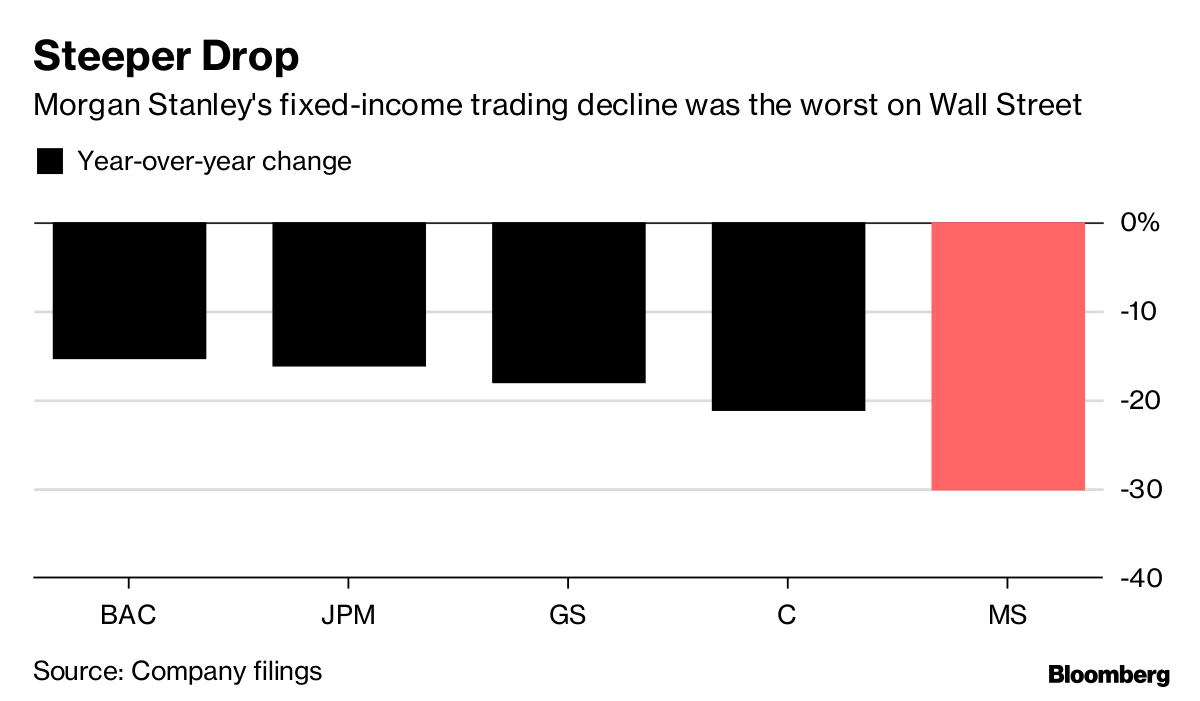Jan 17, 2019
Morgan Stanley suffers worst bond-trading slump on Wall Street
, Bloomberg News

Morgan Stanley’s fixed-income traders succumbed to the same downturn that afflicted the rest of Wall Street in the fourth quarter, posting their worst results in three years.
Bond-trading revenue tumbled 30 per cent to US$564 million, the New York based company said Thursday in a statement. The drop was the biggest of the five largest U.S. investment banks and well below the US$823 million average estimate of analysts.
Clients spooked by extended bouts of volatility, especially during December, also left fixed-income operations reeling at Goldman Sachs Group Inc., Citigroup Inc. and JPMorgan Chase & Co., which reported results earlier this week. Morgan Stanley blamed credit and rates products, but indicated the tone improved as 2019 got under way.
“The market backdrop we saw in November and December has clearly been replaced by a more constructive tone” for the fixed-income business, Chief Financial Officer Jonathan Pruzan said in a telephone interview. He said even during the challenging period at the end of last year, the commodities operation had a good quarter.

Shares of Morgan Stanley dropped 5.1 per cent to US$42.24 at 9:42 a.m. in New York, the worst performance in the 68-company S&P 500 Financials Index.
Equities trading also trailed rivals, little changed from a year earlier while the firm’s competitors posted gains. Pruzan said that the firm’s equities result was roughly in-line with peers when excluding margin loan losses that many rivals took in last year’s fourth quarter. Wall Street firms including Bank of America Corp. were forced to book losses in 2017 on loans to Steinhoff International Holdings NV, a furniture retailer rocked by an accounting scandal.
“The pain of the fourth quarter’s challenging market conditions was felt broadly across the Morgan Stanley franchise,” Susan Katzke, an analyst at Credit Suisse Group AG, wrote in a note to clients.
Morgan Stanley’s merger-advisory work benefited from a dealmaking boom that pushed revenue from that business 41 per cent higher to US$734 million. That beat the average estimate of US$605 million. Pruzan said the firm’s deal pipeline is healthy and confidence among corporate chief executive officers is good.
The firm said in a separate presentation that it was maintaining its previous guidance on return on equity, saying it expects the profit measure to hold between 10 per cent and 13 per cent in the medium term.
Chief Executive Officer James Gorman said on a call with analysts that Morgan Stanley has more opportunities for growth through hiring and potential acquisitions. He said he’s considering purchases for both wealth and asset management.
The investment-management division’s fixed-income offering is “smaller than we would like,” Gorman said on a call with analysts.
“There are a lot of spaces where we can add on,” Gorman said. “We’re not suggesting we’re about to do a mega-deal in asset management. You and I and everyone else knows those are complicated, and not all of those have been successful.”
Read more about Gorman’s willingness to look for acquisitions
Even as bond-trading sinks deeper into decline, big banks are setting records in other areas. They had already topped US$100 billion in annual profit for the first time before Morgan Stanley reported results. Credit goes to the U.S. tax overhaul that cut levies on lenders, rising interest rates and a retail-banking boom.
Other key results:
Net income more than doubled to US$1.53 billion, or 80 cents a share, from US$643 million, or 26 cents, a year earlier, when the firm took a charge related to the U.S. tax overhaul. Revenue fell 10 per cent to US$8.55 billion as the firm’s wealth-management unit posted a 6 per cent decline.




